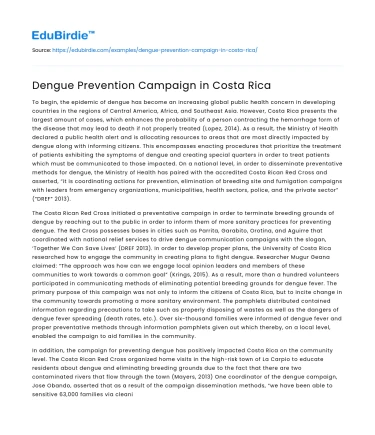To begin, the epidemic of dengue has become an increasing global public health concern in developing countries in the regions of Central America, Africa, and Southeast Asia. However, Costa Rica presents the largest amount of cases, which enhances the probability of a person contracting the hemorrhage form of the disease that may lead to death if not properly treated (Lopez, 2014). As a result, the Ministry of Health declared a public health alert and is allocating resources to areas that are most directly impacted by dengue along with informing citizens. This encompasses enacting procedures that prioritize the treatment of patients exhibiting the symptoms of dengue and creating special quarters in order to treat patients which must be communicated to those impacted. On a national level, in order to disseminate preventative methods for dengue, the Ministry of Health has paired with the accredited Costa Rican Red Cross and asserted, “it is coordinating actions for prevention, elimination of breeding site and fumigation campaigns with leaders from emergency organizations, municipalities, health sectors, police, and the private sector” (“DREF” 2013).
The Costa Rican Red Cross initiated a preventative campaign in order to terminate breeding grounds of dengue by reaching out to the public in order to inform them of more sanitary practices for preventing dengue. The Red Cross possesses bases in cities such as Parrita, Garabito, Orotina, and Aguirre that coordinated with national relief services to drive dengue communication campaigns with the slogan, ‘Together We Can Save Lives’ (DREF 2013). In order to develop proper plans, the University of Costa Rica researched how to engage the community in creating plans to fight dengue. Researcher Mugur Geana claimed: “The approach was how can we engage local opinion leaders and members of these communities to work towards a common goal” (Krings, 2015). As a result, more than a hundred volunteers participated in communicating methods of eliminating potential breeding grounds for dengue fever. The primary purpose of this campaign was not only to inform the citizens of Costa Rica, but to incite change in the community towards promoting a more sanitary environment. The pamphlets distributed contained information regarding precautions to take such as properly disposing of wastes as well as the dangers of dengue fever spreading (death rates, etc.). Over six-thousand families were informed of dengue fever and proper preventative methods through information pamphlets given out which thereby, on a local level, enabled the campaign to aid families in the community.
Save your time!
We can take care of your essay
- Proper editing and formatting
- Free revision, title page, and bibliography
- Flexible prices and money-back guarantee
In addition, the campaign for preventing dengue has positively impacted Costa Rica on the community level. The Costa Rican Red Cross organized home visits in the high-risk town of La Carpio to educate residents about dengue and eliminating breeding grounds due to the fact that there are two contaminated rivers that flow through the town (Mayers, 2013) One coordinator of the dengue campaign, Jose Obando, asserted that as a result of the campaign dissemination methods, “we have been able to sensitive 63,000 families via cleaning campaigns, fumigations, and home visits in areas that are difficult to access”(Mayers 2013).
Overall, the dengue informational pamphlets given out were effective in properly conveying the risks and defensive methods against potential grounds for the breeding of the virus since this public health campaign was supported at the national and community level. However, while numerous families may be taking preventative measures, there are those that will continue to contaminate the environment by not eliminating waste properly. This signifies that successful measures against the spread of dengue relies on active involvement of the community in which not all members may choose to comply. Cases of dengue have been shown to primarily impact poor communities that do not possess proper housing and adequate water supplies (Badia, 2013), so instead of simply informing the public of the dangers of dengue, the campaign would be more effective if more financial aid was allocated towards communities in need. This action would ensure that families will be able to live in sanitary conditions which therefore minimizes the risk of contracting dengue. Developing nations possess numerous economic and social barriers that avert proper environmental maintenance, but with increased coordination with national public health services to aid communities in poverty (providing clean water/proper housing) the Costa Rican Red Cross would be even more effective in minimizing cases of dengue annually.






 Stuck on your essay?
Stuck on your essay?

